HA3011 Advanced Financial Accounting: GWA Group Limited Financials
VerifiedAdded on 2023/04/04
|10
|2736
|407
Report
AI Summary
This report provides an in-depth analysis of advanced financial accounting concepts and their application to GWA Group Limited. It begins by describing key accounting concepts such as the business entity concept, money measurement concept, and going concern concept, illustrating their relevance to financial reporting. The report then examines the conceptual framework of financial statements, discussing accounting principles like objectivity, matching, consistency, and revenue recognition. Issues related to measurement, including the role of discounting and the maintenance of capital, are also addressed. Furthermore, the report explores fundamental qualitative characteristics of accounting information, such as relevance, representational faithfulness, verifiability, timeliness, understandability, and comparability, evaluating GWA Group Limited's adherence to these characteristics in its financial statements. This comprehensive analysis offers valuable insights into the theoretical models of accounting and their practical implications for financial reporting.
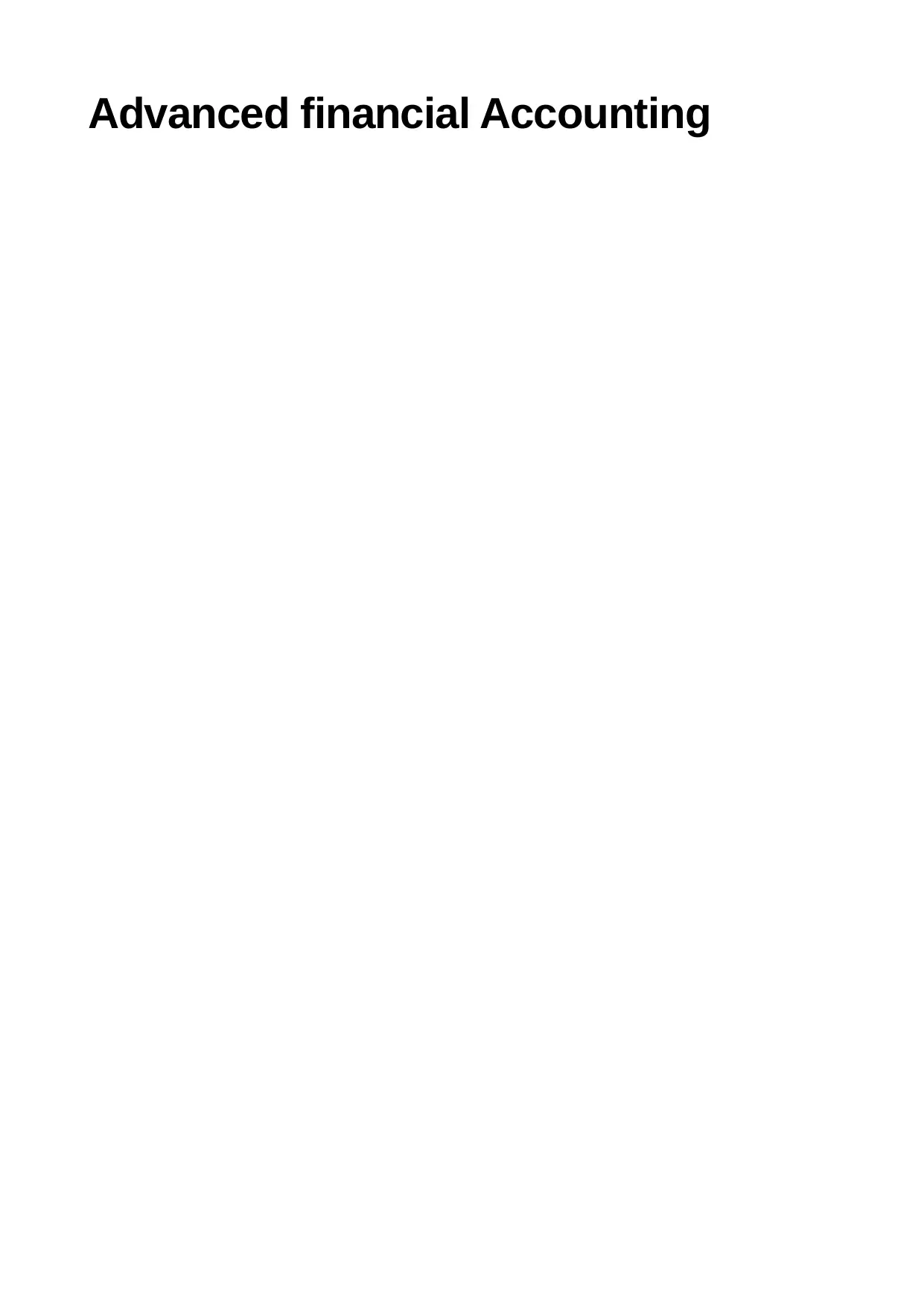
Advanced financial Accounting
Paraphrase This Document
Need a fresh take? Get an instant paraphrase of this document with our AI Paraphraser
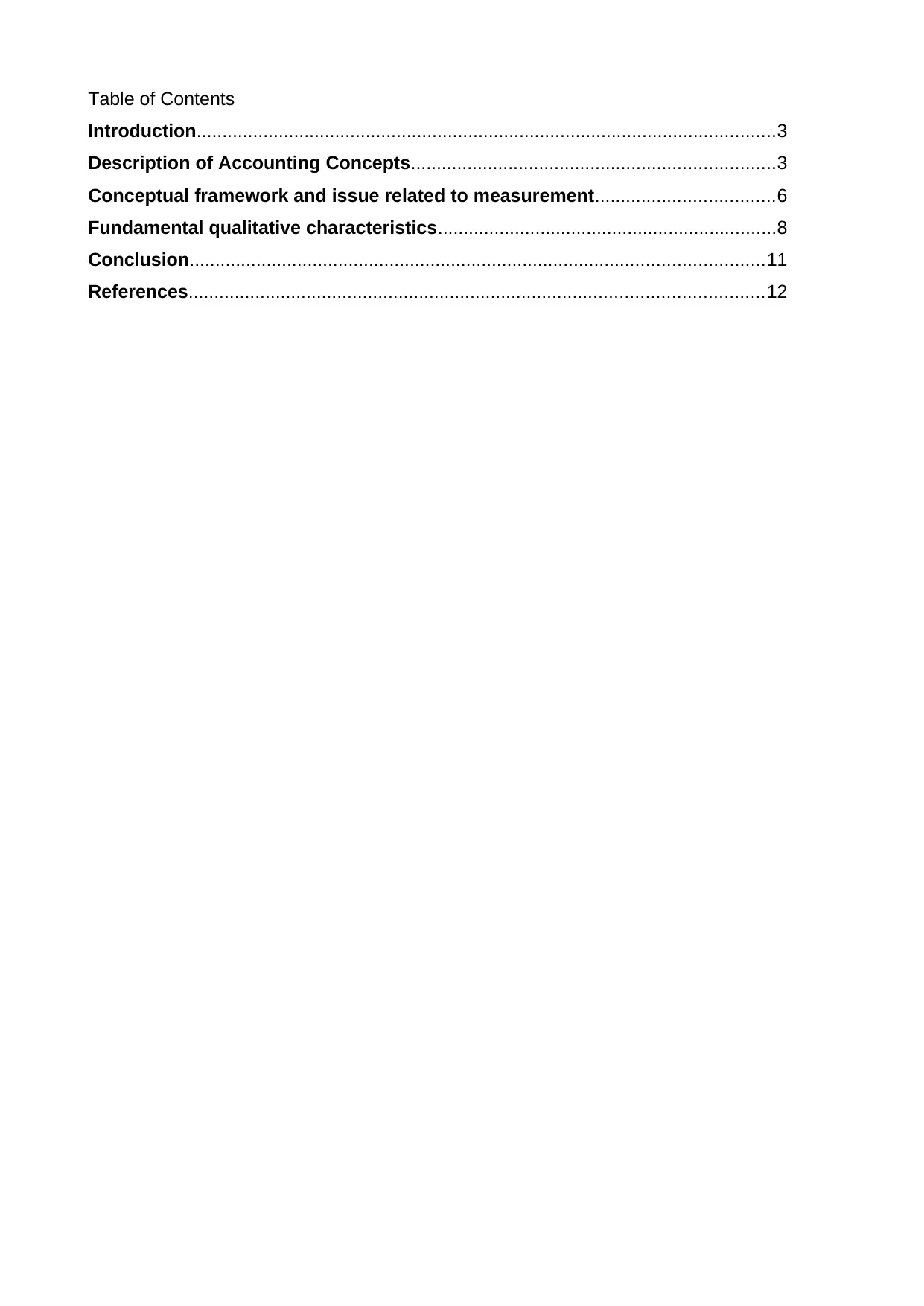
Table of Contents
Introduction.................................................................................................................3
Description of Accounting Concepts.......................................................................3
Conceptual framework and issue related to measurement...................................6
Fundamental qualitative characteristics..................................................................8
Conclusion................................................................................................................11
References................................................................................................................12
Introduction.................................................................................................................3
Description of Accounting Concepts.......................................................................3
Conceptual framework and issue related to measurement...................................6
Fundamental qualitative characteristics..................................................................8
Conclusion................................................................................................................11
References................................................................................................................12
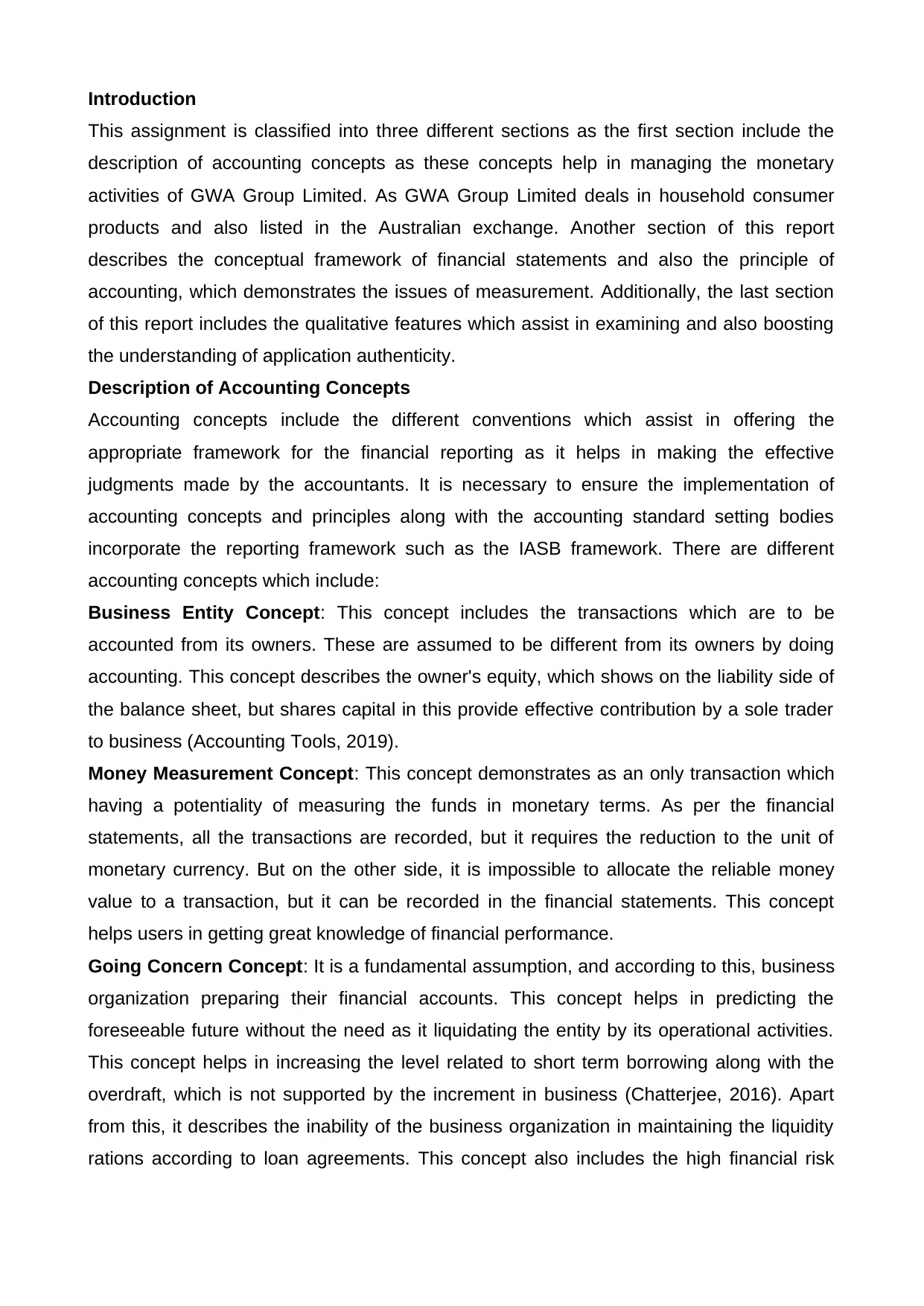
Introduction
This assignment is classified into three different sections as the first section include the
description of accounting concepts as these concepts help in managing the monetary
activities of GWA Group Limited. As GWA Group Limited deals in household consumer
products and also listed in the Australian exchange. Another section of this report
describes the conceptual framework of financial statements and also the principle of
accounting, which demonstrates the issues of measurement. Additionally, the last section
of this report includes the qualitative features which assist in examining and also boosting
the understanding of application authenticity.
Description of Accounting Concepts
Accounting concepts include the different conventions which assist in offering the
appropriate framework for the financial reporting as it helps in making the effective
judgments made by the accountants. It is necessary to ensure the implementation of
accounting concepts and principles along with the accounting standard setting bodies
incorporate the reporting framework such as the IASB framework. There are different
accounting concepts which include:
Business Entity Concept: This concept includes the transactions which are to be
accounted from its owners. These are assumed to be different from its owners by doing
accounting. This concept describes the owner's equity, which shows on the liability side of
the balance sheet, but shares capital in this provide effective contribution by a sole trader
to business (Accounting Tools, 2019).
Money Measurement Concept: This concept demonstrates as an only transaction which
having a potentiality of measuring the funds in monetary terms. As per the financial
statements, all the transactions are recorded, but it requires the reduction to the unit of
monetary currency. But on the other side, it is impossible to allocate the reliable money
value to a transaction, but it can be recorded in the financial statements. This concept
helps users in getting great knowledge of financial performance.
Going Concern Concept: It is a fundamental assumption, and according to this, business
organization preparing their financial accounts. This concept helps in predicting the
foreseeable future without the need as it liquidating the entity by its operational activities.
This concept helps in increasing the level related to short term borrowing along with the
overdraft, which is not supported by the increment in business (Chatterjee, 2016). Apart
from this, it describes the inability of the business organization in maintaining the liquidity
rations according to loan agreements. This concept also includes the high financial risk
This assignment is classified into three different sections as the first section include the
description of accounting concepts as these concepts help in managing the monetary
activities of GWA Group Limited. As GWA Group Limited deals in household consumer
products and also listed in the Australian exchange. Another section of this report
describes the conceptual framework of financial statements and also the principle of
accounting, which demonstrates the issues of measurement. Additionally, the last section
of this report includes the qualitative features which assist in examining and also boosting
the understanding of application authenticity.
Description of Accounting Concepts
Accounting concepts include the different conventions which assist in offering the
appropriate framework for the financial reporting as it helps in making the effective
judgments made by the accountants. It is necessary to ensure the implementation of
accounting concepts and principles along with the accounting standard setting bodies
incorporate the reporting framework such as the IASB framework. There are different
accounting concepts which include:
Business Entity Concept: This concept includes the transactions which are to be
accounted from its owners. These are assumed to be different from its owners by doing
accounting. This concept describes the owner's equity, which shows on the liability side of
the balance sheet, but shares capital in this provide effective contribution by a sole trader
to business (Accounting Tools, 2019).
Money Measurement Concept: This concept demonstrates as an only transaction which
having a potentiality of measuring the funds in monetary terms. As per the financial
statements, all the transactions are recorded, but it requires the reduction to the unit of
monetary currency. But on the other side, it is impossible to allocate the reliable money
value to a transaction, but it can be recorded in the financial statements. This concept
helps users in getting great knowledge of financial performance.
Going Concern Concept: It is a fundamental assumption, and according to this, business
organization preparing their financial accounts. This concept helps in predicting the
foreseeable future without the need as it liquidating the entity by its operational activities.
This concept helps in increasing the level related to short term borrowing along with the
overdraft, which is not supported by the increment in business (Chatterjee, 2016). Apart
from this, it describes the inability of the business organization in maintaining the liquidity
rations according to loan agreements. This concept also includes the high financial risk
⊘ This is a preview!⊘
Do you want full access?
Subscribe today to unlock all pages.

Trusted by 1+ million students worldwide
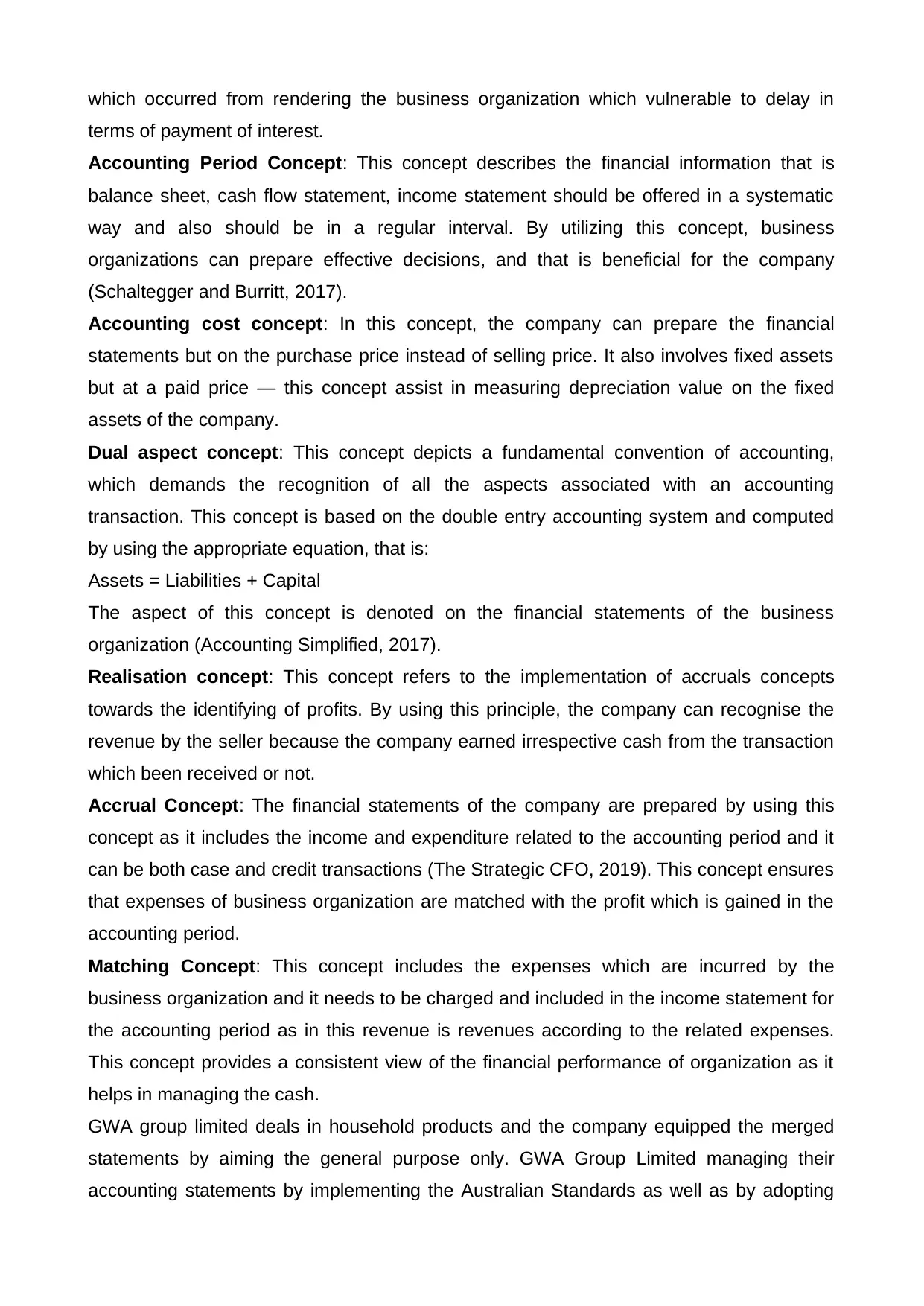
which occurred from rendering the business organization which vulnerable to delay in
terms of payment of interest.
Accounting Period Concept: This concept describes the financial information that is
balance sheet, cash flow statement, income statement should be offered in a systematic
way and also should be in a regular interval. By utilizing this concept, business
organizations can prepare effective decisions, and that is beneficial for the company
(Schaltegger and Burritt, 2017).
Accounting cost concept: In this concept, the company can prepare the financial
statements but on the purchase price instead of selling price. It also involves fixed assets
but at a paid price — this concept assist in measuring depreciation value on the fixed
assets of the company.
Dual aspect concept: This concept depicts a fundamental convention of accounting,
which demands the recognition of all the aspects associated with an accounting
transaction. This concept is based on the double entry accounting system and computed
by using the appropriate equation, that is:
Assets = Liabilities + Capital
The aspect of this concept is denoted on the financial statements of the business
organization (Accounting Simplified, 2017).
Realisation concept: This concept refers to the implementation of accruals concepts
towards the identifying of profits. By using this principle, the company can recognise the
revenue by the seller because the company earned irrespective cash from the transaction
which been received or not.
Accrual Concept: The financial statements of the company are prepared by using this
concept as it includes the income and expenditure related to the accounting period and it
can be both case and credit transactions (The Strategic CFO, 2019). This concept ensures
that expenses of business organization are matched with the profit which is gained in the
accounting period.
Matching Concept: This concept includes the expenses which are incurred by the
business organization and it needs to be charged and included in the income statement for
the accounting period as in this revenue is revenues according to the related expenses.
This concept provides a consistent view of the financial performance of organization as it
helps in managing the cash.
GWA group limited deals in household products and the company equipped the merged
statements by aiming the general purpose only. GWA Group Limited managing their
accounting statements by implementing the Australian Standards as well as by adopting
terms of payment of interest.
Accounting Period Concept: This concept describes the financial information that is
balance sheet, cash flow statement, income statement should be offered in a systematic
way and also should be in a regular interval. By utilizing this concept, business
organizations can prepare effective decisions, and that is beneficial for the company
(Schaltegger and Burritt, 2017).
Accounting cost concept: In this concept, the company can prepare the financial
statements but on the purchase price instead of selling price. It also involves fixed assets
but at a paid price — this concept assist in measuring depreciation value on the fixed
assets of the company.
Dual aspect concept: This concept depicts a fundamental convention of accounting,
which demands the recognition of all the aspects associated with an accounting
transaction. This concept is based on the double entry accounting system and computed
by using the appropriate equation, that is:
Assets = Liabilities + Capital
The aspect of this concept is denoted on the financial statements of the business
organization (Accounting Simplified, 2017).
Realisation concept: This concept refers to the implementation of accruals concepts
towards the identifying of profits. By using this principle, the company can recognise the
revenue by the seller because the company earned irrespective cash from the transaction
which been received or not.
Accrual Concept: The financial statements of the company are prepared by using this
concept as it includes the income and expenditure related to the accounting period and it
can be both case and credit transactions (The Strategic CFO, 2019). This concept ensures
that expenses of business organization are matched with the profit which is gained in the
accounting period.
Matching Concept: This concept includes the expenses which are incurred by the
business organization and it needs to be charged and included in the income statement for
the accounting period as in this revenue is revenues according to the related expenses.
This concept provides a consistent view of the financial performance of organization as it
helps in managing the cash.
GWA group limited deals in household products and the company equipped the merged
statements by aiming the general purpose only. GWA Group Limited managing their
accounting statements by implementing the Australian Standards as well as by adopting
Paraphrase This Document
Need a fresh take? Get an instant paraphrase of this document with our AI Paraphraser
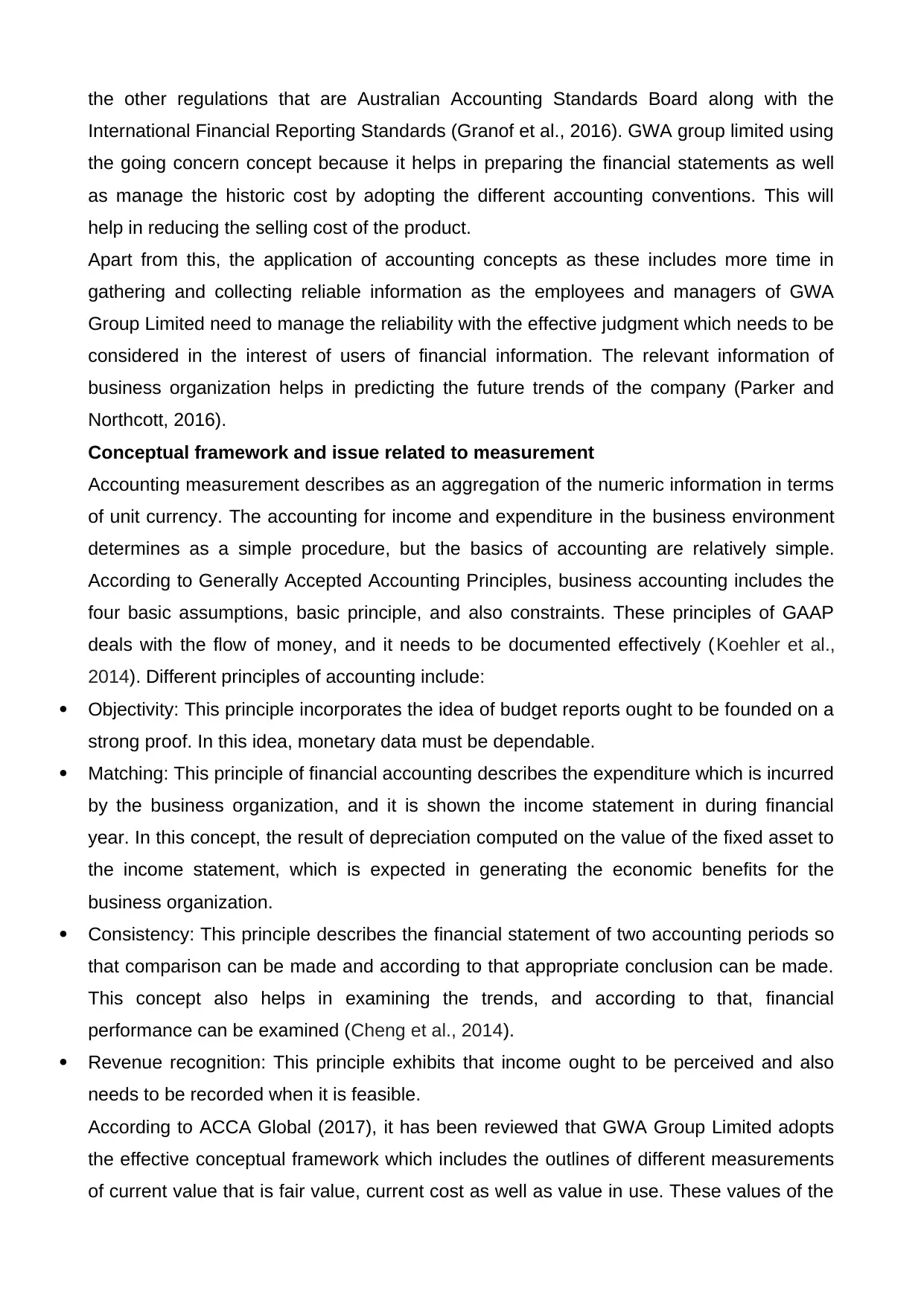
the other regulations that are Australian Accounting Standards Board along with the
International Financial Reporting Standards (Granof et al., 2016). GWA group limited using
the going concern concept because it helps in preparing the financial statements as well
as manage the historic cost by adopting the different accounting conventions. This will
help in reducing the selling cost of the product.
Apart from this, the application of accounting concepts as these includes more time in
gathering and collecting reliable information as the employees and managers of GWA
Group Limited need to manage the reliability with the effective judgment which needs to be
considered in the interest of users of financial information. The relevant information of
business organization helps in predicting the future trends of the company (Parker and
Northcott, 2016).
Conceptual framework and issue related to measurement
Accounting measurement describes as an aggregation of the numeric information in terms
of unit currency. The accounting for income and expenditure in the business environment
determines as a simple procedure, but the basics of accounting are relatively simple.
According to Generally Accepted Accounting Principles, business accounting includes the
four basic assumptions, basic principle, and also constraints. These principles of GAAP
deals with the flow of money, and it needs to be documented effectively ( Koehler et al.,
2014). Different principles of accounting include:
Objectivity: This principle incorporates the idea of budget reports ought to be founded on a
strong proof. In this idea, monetary data must be dependable.
Matching: This principle of financial accounting describes the expenditure which is incurred
by the business organization, and it is shown the income statement in during financial
year. In this concept, the result of depreciation computed on the value of the fixed asset to
the income statement, which is expected in generating the economic benefits for the
business organization.
Consistency: This principle describes the financial statement of two accounting periods so
that comparison can be made and according to that appropriate conclusion can be made.
This concept also helps in examining the trends, and according to that, financial
performance can be examined (Cheng et al., 2014).
Revenue recognition: This principle exhibits that income ought to be perceived and also
needs to be recorded when it is feasible.
According to ACCA Global (2017), it has been reviewed that GWA Group Limited adopts
the effective conceptual framework which includes the outlines of different measurements
of current value that is fair value, current cost as well as value in use. These values of the
International Financial Reporting Standards (Granof et al., 2016). GWA group limited using
the going concern concept because it helps in preparing the financial statements as well
as manage the historic cost by adopting the different accounting conventions. This will
help in reducing the selling cost of the product.
Apart from this, the application of accounting concepts as these includes more time in
gathering and collecting reliable information as the employees and managers of GWA
Group Limited need to manage the reliability with the effective judgment which needs to be
considered in the interest of users of financial information. The relevant information of
business organization helps in predicting the future trends of the company (Parker and
Northcott, 2016).
Conceptual framework and issue related to measurement
Accounting measurement describes as an aggregation of the numeric information in terms
of unit currency. The accounting for income and expenditure in the business environment
determines as a simple procedure, but the basics of accounting are relatively simple.
According to Generally Accepted Accounting Principles, business accounting includes the
four basic assumptions, basic principle, and also constraints. These principles of GAAP
deals with the flow of money, and it needs to be documented effectively ( Koehler et al.,
2014). Different principles of accounting include:
Objectivity: This principle incorporates the idea of budget reports ought to be founded on a
strong proof. In this idea, monetary data must be dependable.
Matching: This principle of financial accounting describes the expenditure which is incurred
by the business organization, and it is shown the income statement in during financial
year. In this concept, the result of depreciation computed on the value of the fixed asset to
the income statement, which is expected in generating the economic benefits for the
business organization.
Consistency: This principle describes the financial statement of two accounting periods so
that comparison can be made and according to that appropriate conclusion can be made.
This concept also helps in examining the trends, and according to that, financial
performance can be examined (Cheng et al., 2014).
Revenue recognition: This principle exhibits that income ought to be perceived and also
needs to be recorded when it is feasible.
According to ACCA Global (2017), it has been reviewed that GWA Group Limited adopts
the effective conceptual framework which includes the outlines of different measurements
of current value that is fair value, current cost as well as value in use. These values of the
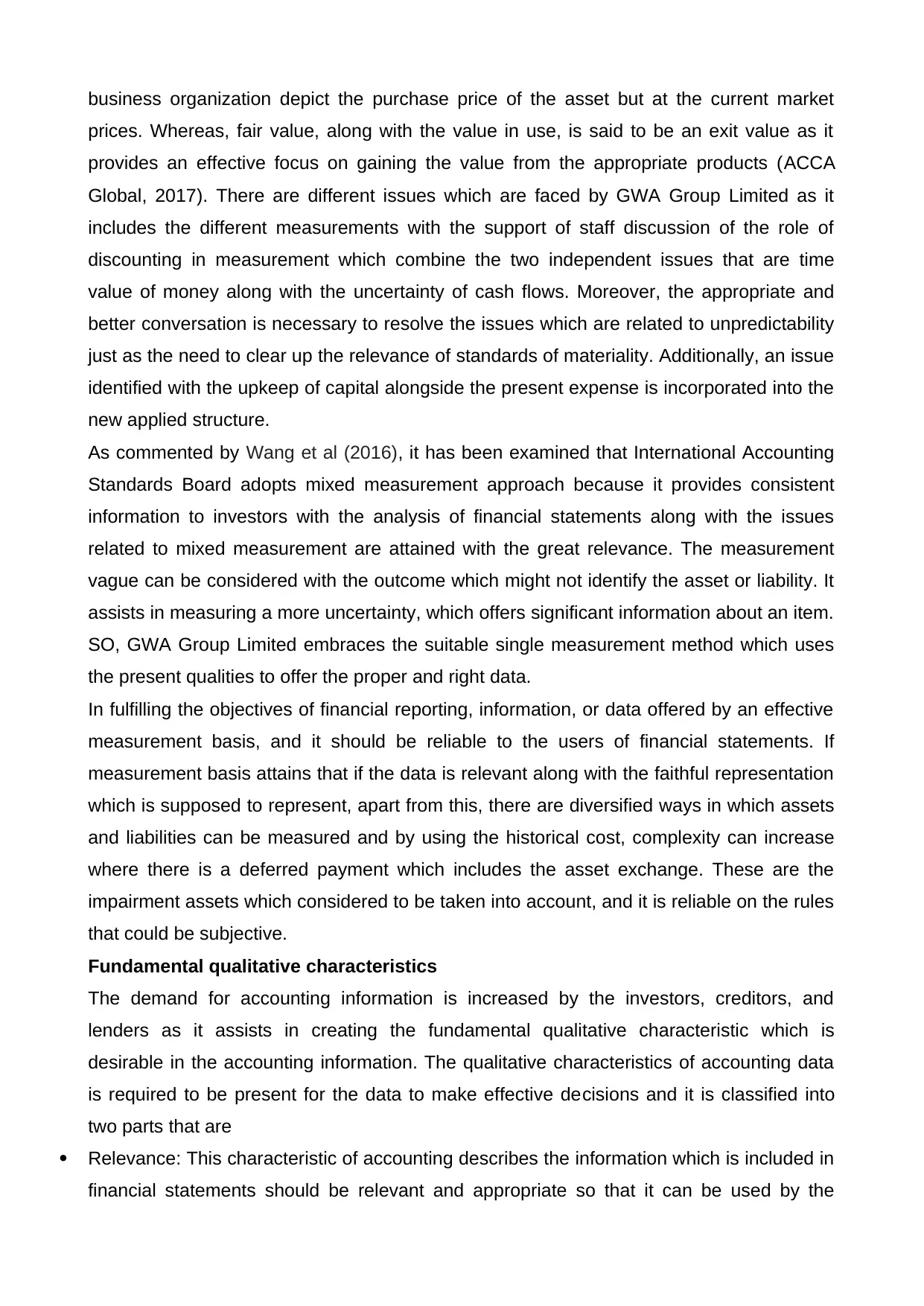
business organization depict the purchase price of the asset but at the current market
prices. Whereas, fair value, along with the value in use, is said to be an exit value as it
provides an effective focus on gaining the value from the appropriate products (ACCA
Global, 2017). There are different issues which are faced by GWA Group Limited as it
includes the different measurements with the support of staff discussion of the role of
discounting in measurement which combine the two independent issues that are time
value of money along with the uncertainty of cash flows. Moreover, the appropriate and
better conversation is necessary to resolve the issues which are related to unpredictability
just as the need to clear up the relevance of standards of materiality. Additionally, an issue
identified with the upkeep of capital alongside the present expense is incorporated into the
new applied structure.
As commented by Wang et al (2016), it has been examined that International Accounting
Standards Board adopts mixed measurement approach because it provides consistent
information to investors with the analysis of financial statements along with the issues
related to mixed measurement are attained with the great relevance. The measurement
vague can be considered with the outcome which might not identify the asset or liability. It
assists in measuring a more uncertainty, which offers significant information about an item.
SO, GWA Group Limited embraces the suitable single measurement method which uses
the present qualities to offer the proper and right data.
In fulfilling the objectives of financial reporting, information, or data offered by an effective
measurement basis, and it should be reliable to the users of financial statements. If
measurement basis attains that if the data is relevant along with the faithful representation
which is supposed to represent, apart from this, there are diversified ways in which assets
and liabilities can be measured and by using the historical cost, complexity can increase
where there is a deferred payment which includes the asset exchange. These are the
impairment assets which considered to be taken into account, and it is reliable on the rules
that could be subjective.
Fundamental qualitative characteristics
The demand for accounting information is increased by the investors, creditors, and
lenders as it assists in creating the fundamental qualitative characteristic which is
desirable in the accounting information. The qualitative characteristics of accounting data
is required to be present for the data to make effective decisions and it is classified into
two parts that are
Relevance: This characteristic of accounting describes the information which is included in
financial statements should be relevant and appropriate so that it can be used by the
prices. Whereas, fair value, along with the value in use, is said to be an exit value as it
provides an effective focus on gaining the value from the appropriate products (ACCA
Global, 2017). There are different issues which are faced by GWA Group Limited as it
includes the different measurements with the support of staff discussion of the role of
discounting in measurement which combine the two independent issues that are time
value of money along with the uncertainty of cash flows. Moreover, the appropriate and
better conversation is necessary to resolve the issues which are related to unpredictability
just as the need to clear up the relevance of standards of materiality. Additionally, an issue
identified with the upkeep of capital alongside the present expense is incorporated into the
new applied structure.
As commented by Wang et al (2016), it has been examined that International Accounting
Standards Board adopts mixed measurement approach because it provides consistent
information to investors with the analysis of financial statements along with the issues
related to mixed measurement are attained with the great relevance. The measurement
vague can be considered with the outcome which might not identify the asset or liability. It
assists in measuring a more uncertainty, which offers significant information about an item.
SO, GWA Group Limited embraces the suitable single measurement method which uses
the present qualities to offer the proper and right data.
In fulfilling the objectives of financial reporting, information, or data offered by an effective
measurement basis, and it should be reliable to the users of financial statements. If
measurement basis attains that if the data is relevant along with the faithful representation
which is supposed to represent, apart from this, there are diversified ways in which assets
and liabilities can be measured and by using the historical cost, complexity can increase
where there is a deferred payment which includes the asset exchange. These are the
impairment assets which considered to be taken into account, and it is reliable on the rules
that could be subjective.
Fundamental qualitative characteristics
The demand for accounting information is increased by the investors, creditors, and
lenders as it assists in creating the fundamental qualitative characteristic which is
desirable in the accounting information. The qualitative characteristics of accounting data
is required to be present for the data to make effective decisions and it is classified into
two parts that are
Relevance: This characteristic of accounting describes the information which is included in
financial statements should be relevant and appropriate so that it can be used by the
⊘ This is a preview!⊘
Do you want full access?
Subscribe today to unlock all pages.

Trusted by 1+ million students worldwide
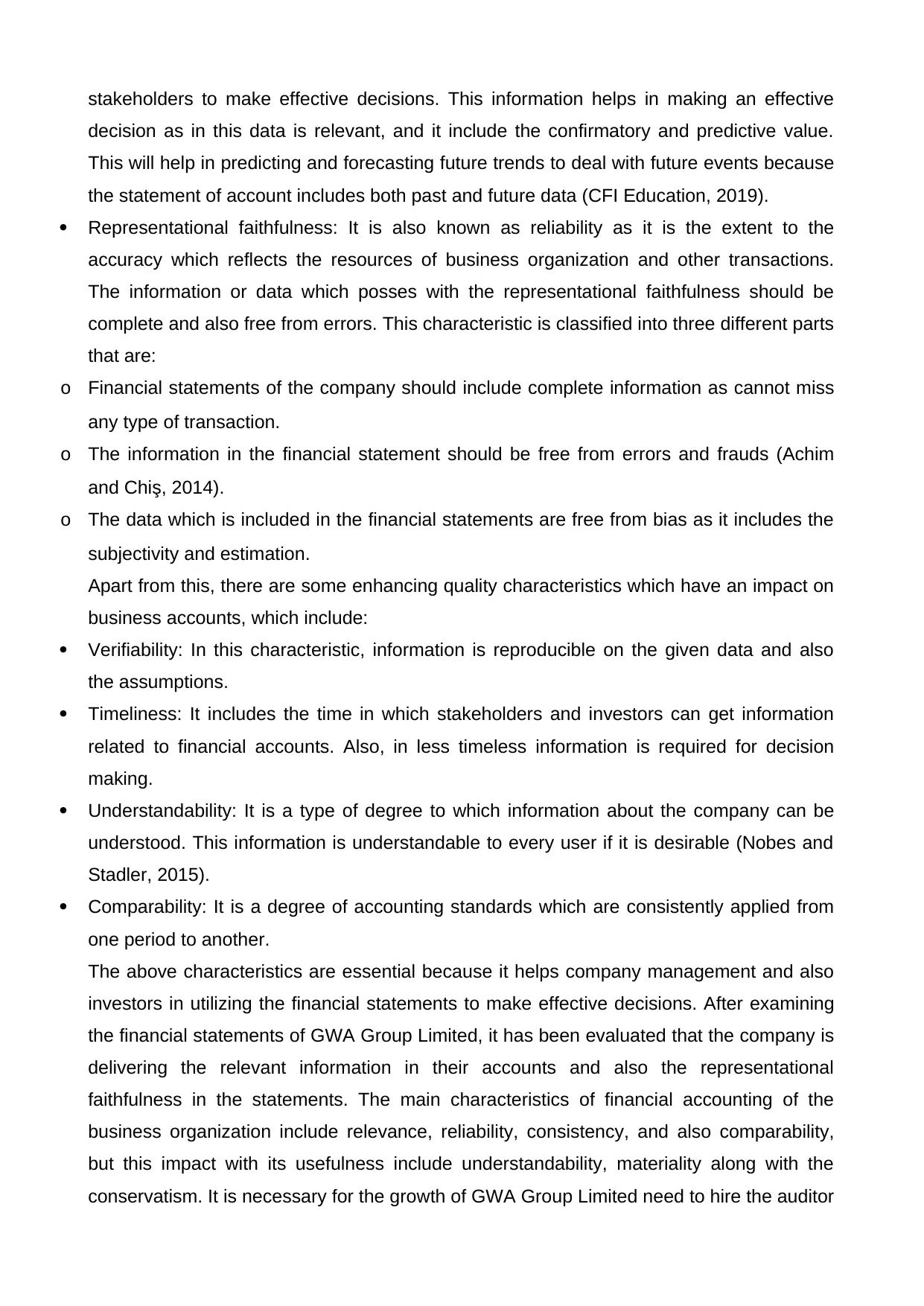
stakeholders to make effective decisions. This information helps in making an effective
decision as in this data is relevant, and it include the confirmatory and predictive value.
This will help in predicting and forecasting future trends to deal with future events because
the statement of account includes both past and future data (CFI Education, 2019).
Representational faithfulness: It is also known as reliability as it is the extent to the
accuracy which reflects the resources of business organization and other transactions.
The information or data which posses with the representational faithfulness should be
complete and also free from errors. This characteristic is classified into three different parts
that are:
o Financial statements of the company should include complete information as cannot miss
any type of transaction.
o The information in the financial statement should be free from errors and frauds (Achim
and Chiş, 2014).
o The data which is included in the financial statements are free from bias as it includes the
subjectivity and estimation.
Apart from this, there are some enhancing quality characteristics which have an impact on
business accounts, which include:
Verifiability: In this characteristic, information is reproducible on the given data and also
the assumptions.
Timeliness: It includes the time in which stakeholders and investors can get information
related to financial accounts. Also, in less timeless information is required for decision
making.
Understandability: It is a type of degree to which information about the company can be
understood. This information is understandable to every user if it is desirable (Nobes and
Stadler, 2015).
Comparability: It is a degree of accounting standards which are consistently applied from
one period to another.
The above characteristics are essential because it helps company management and also
investors in utilizing the financial statements to make effective decisions. After examining
the financial statements of GWA Group Limited, it has been evaluated that the company is
delivering the relevant information in their accounts and also the representational
faithfulness in the statements. The main characteristics of financial accounting of the
business organization include relevance, reliability, consistency, and also comparability,
but this impact with its usefulness include understandability, materiality along with the
conservatism. It is necessary for the growth of GWA Group Limited need to hire the auditor
decision as in this data is relevant, and it include the confirmatory and predictive value.
This will help in predicting and forecasting future trends to deal with future events because
the statement of account includes both past and future data (CFI Education, 2019).
Representational faithfulness: It is also known as reliability as it is the extent to the
accuracy which reflects the resources of business organization and other transactions.
The information or data which posses with the representational faithfulness should be
complete and also free from errors. This characteristic is classified into three different parts
that are:
o Financial statements of the company should include complete information as cannot miss
any type of transaction.
o The information in the financial statement should be free from errors and frauds (Achim
and Chiş, 2014).
o The data which is included in the financial statements are free from bias as it includes the
subjectivity and estimation.
Apart from this, there are some enhancing quality characteristics which have an impact on
business accounts, which include:
Verifiability: In this characteristic, information is reproducible on the given data and also
the assumptions.
Timeliness: It includes the time in which stakeholders and investors can get information
related to financial accounts. Also, in less timeless information is required for decision
making.
Understandability: It is a type of degree to which information about the company can be
understood. This information is understandable to every user if it is desirable (Nobes and
Stadler, 2015).
Comparability: It is a degree of accounting standards which are consistently applied from
one period to another.
The above characteristics are essential because it helps company management and also
investors in utilizing the financial statements to make effective decisions. After examining
the financial statements of GWA Group Limited, it has been evaluated that the company is
delivering the relevant information in their accounts and also the representational
faithfulness in the statements. The main characteristics of financial accounting of the
business organization include relevance, reliability, consistency, and also comparability,
but this impact with its usefulness include understandability, materiality along with the
conservatism. It is necessary for the growth of GWA Group Limited need to hire the auditor
Paraphrase This Document
Need a fresh take? Get an instant paraphrase of this document with our AI Paraphraser
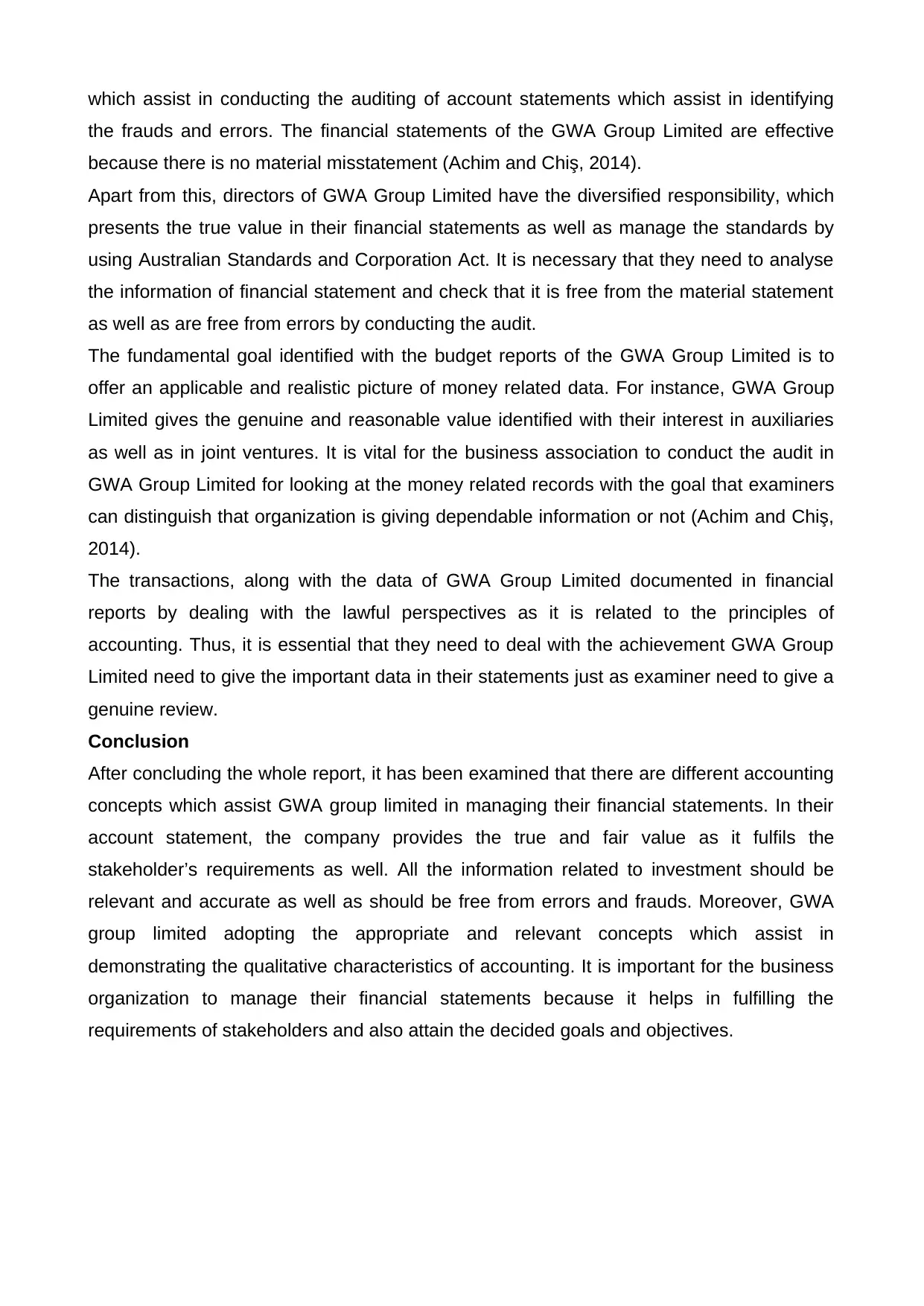
which assist in conducting the auditing of account statements which assist in identifying
the frauds and errors. The financial statements of the GWA Group Limited are effective
because there is no material misstatement (Achim and Chiş, 2014).
Apart from this, directors of GWA Group Limited have the diversified responsibility, which
presents the true value in their financial statements as well as manage the standards by
using Australian Standards and Corporation Act. It is necessary that they need to analyse
the information of financial statement and check that it is free from the material statement
as well as are free from errors by conducting the audit.
The fundamental goal identified with the budget reports of the GWA Group Limited is to
offer an applicable and realistic picture of money related data. For instance, GWA Group
Limited gives the genuine and reasonable value identified with their interest in auxiliaries
as well as in joint ventures. It is vital for the business association to conduct the audit in
GWA Group Limited for looking at the money related records with the goal that examiners
can distinguish that organization is giving dependable information or not (Achim and Chiş,
2014).
The transactions, along with the data of GWA Group Limited documented in financial
reports by dealing with the lawful perspectives as it is related to the principles of
accounting. Thus, it is essential that they need to deal with the achievement GWA Group
Limited need to give the important data in their statements just as examiner need to give a
genuine review.
Conclusion
After concluding the whole report, it has been examined that there are different accounting
concepts which assist GWA group limited in managing their financial statements. In their
account statement, the company provides the true and fair value as it fulfils the
stakeholder’s requirements as well. All the information related to investment should be
relevant and accurate as well as should be free from errors and frauds. Moreover, GWA
group limited adopting the appropriate and relevant concepts which assist in
demonstrating the qualitative characteristics of accounting. It is important for the business
organization to manage their financial statements because it helps in fulfilling the
requirements of stakeholders and also attain the decided goals and objectives.
the frauds and errors. The financial statements of the GWA Group Limited are effective
because there is no material misstatement (Achim and Chiş, 2014).
Apart from this, directors of GWA Group Limited have the diversified responsibility, which
presents the true value in their financial statements as well as manage the standards by
using Australian Standards and Corporation Act. It is necessary that they need to analyse
the information of financial statement and check that it is free from the material statement
as well as are free from errors by conducting the audit.
The fundamental goal identified with the budget reports of the GWA Group Limited is to
offer an applicable and realistic picture of money related data. For instance, GWA Group
Limited gives the genuine and reasonable value identified with their interest in auxiliaries
as well as in joint ventures. It is vital for the business association to conduct the audit in
GWA Group Limited for looking at the money related records with the goal that examiners
can distinguish that organization is giving dependable information or not (Achim and Chiş,
2014).
The transactions, along with the data of GWA Group Limited documented in financial
reports by dealing with the lawful perspectives as it is related to the principles of
accounting. Thus, it is essential that they need to deal with the achievement GWA Group
Limited need to give the important data in their statements just as examiner need to give a
genuine review.
Conclusion
After concluding the whole report, it has been examined that there are different accounting
concepts which assist GWA group limited in managing their financial statements. In their
account statement, the company provides the true and fair value as it fulfils the
stakeholder’s requirements as well. All the information related to investment should be
relevant and accurate as well as should be free from errors and frauds. Moreover, GWA
group limited adopting the appropriate and relevant concepts which assist in
demonstrating the qualitative characteristics of accounting. It is important for the business
organization to manage their financial statements because it helps in fulfilling the
requirements of stakeholders and also attain the decided goals and objectives.
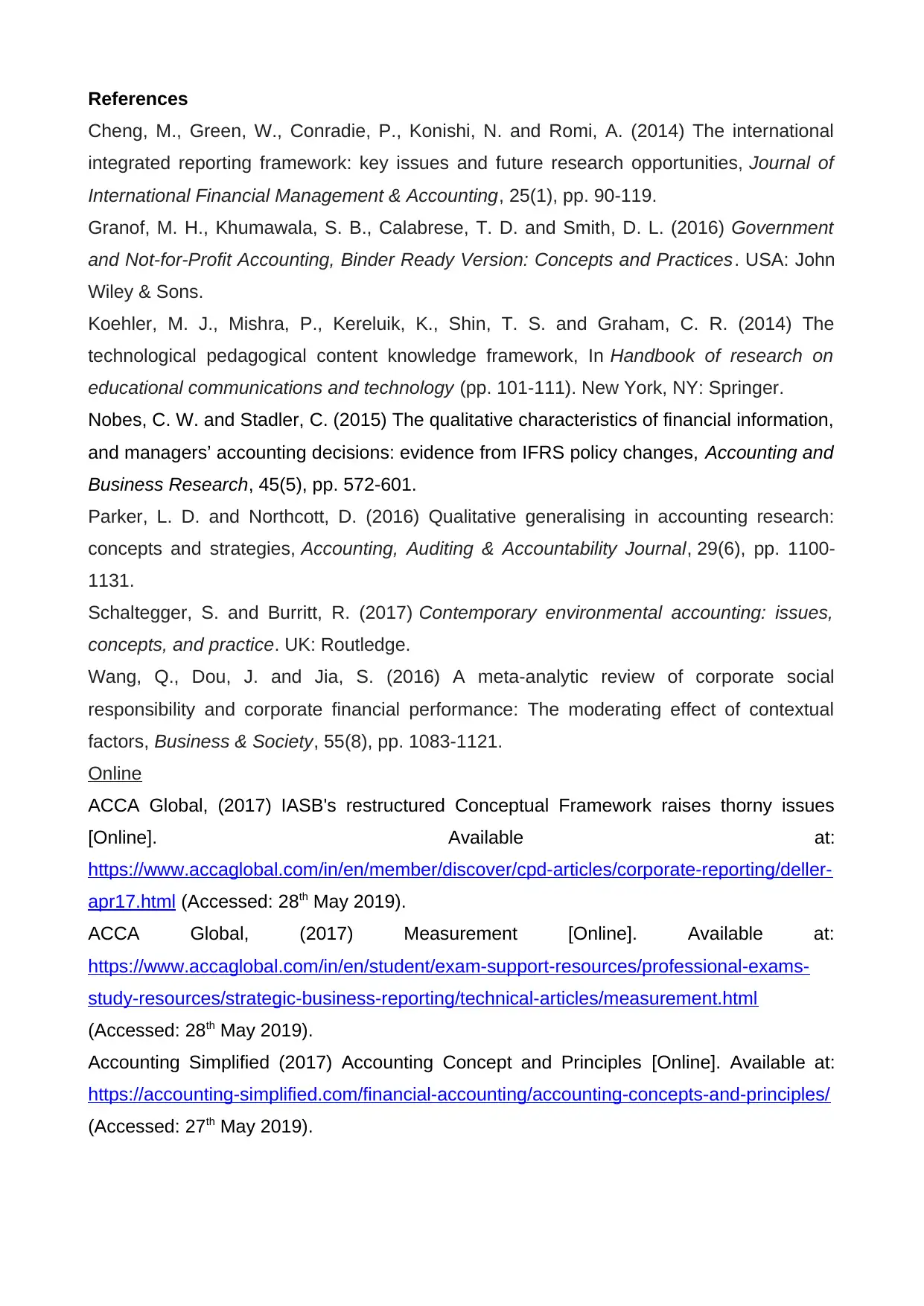
References
Cheng, M., Green, W., Conradie, P., Konishi, N. and Romi, A. (2014) The international
integrated reporting framework: key issues and future research opportunities, Journal of
International Financial Management & Accounting, 25(1), pp. 90-119.
Granof, M. H., Khumawala, S. B., Calabrese, T. D. and Smith, D. L. (2016) Government
and Not-for-Profit Accounting, Binder Ready Version: Concepts and Practices. USA: John
Wiley & Sons.
Koehler, M. J., Mishra, P., Kereluik, K., Shin, T. S. and Graham, C. R. (2014) The
technological pedagogical content knowledge framework, In Handbook of research on
educational communications and technology (pp. 101-111). New York, NY: Springer.
Nobes, C. W. and Stadler, C. (2015) The qualitative characteristics of financial information,
and managers’ accounting decisions: evidence from IFRS policy changes, Accounting and
Business Research, 45(5), pp. 572-601.
Parker, L. D. and Northcott, D. (2016) Qualitative generalising in accounting research:
concepts and strategies, Accounting, Auditing & Accountability Journal, 29(6), pp. 1100-
1131.
Schaltegger, S. and Burritt, R. (2017) Contemporary environmental accounting: issues,
concepts, and practice. UK: Routledge.
Wang, Q., Dou, J. and Jia, S. (2016) A meta-analytic review of corporate social
responsibility and corporate financial performance: The moderating effect of contextual
factors, Business & Society, 55(8), pp. 1083-1121.
Online
ACCA Global, (2017) IASB's restructured Conceptual Framework raises thorny issues
[Online]. Available at:
https://www.accaglobal.com/in/en/member/discover/cpd-articles/corporate-reporting/deller-
apr17.html (Accessed: 28th May 2019).
ACCA Global, (2017) Measurement [Online]. Available at:
https://www.accaglobal.com/in/en/student/exam-support-resources/professional-exams-
study-resources/strategic-business-reporting/technical-articles/measurement.html
(Accessed: 28th May 2019).
Accounting Simplified (2017) Accounting Concept and Principles [Online]. Available at:
https://accounting-simplified.com/financial-accounting/accounting-concepts-and-principles/
(Accessed: 27th May 2019).
Cheng, M., Green, W., Conradie, P., Konishi, N. and Romi, A. (2014) The international
integrated reporting framework: key issues and future research opportunities, Journal of
International Financial Management & Accounting, 25(1), pp. 90-119.
Granof, M. H., Khumawala, S. B., Calabrese, T. D. and Smith, D. L. (2016) Government
and Not-for-Profit Accounting, Binder Ready Version: Concepts and Practices. USA: John
Wiley & Sons.
Koehler, M. J., Mishra, P., Kereluik, K., Shin, T. S. and Graham, C. R. (2014) The
technological pedagogical content knowledge framework, In Handbook of research on
educational communications and technology (pp. 101-111). New York, NY: Springer.
Nobes, C. W. and Stadler, C. (2015) The qualitative characteristics of financial information,
and managers’ accounting decisions: evidence from IFRS policy changes, Accounting and
Business Research, 45(5), pp. 572-601.
Parker, L. D. and Northcott, D. (2016) Qualitative generalising in accounting research:
concepts and strategies, Accounting, Auditing & Accountability Journal, 29(6), pp. 1100-
1131.
Schaltegger, S. and Burritt, R. (2017) Contemporary environmental accounting: issues,
concepts, and practice. UK: Routledge.
Wang, Q., Dou, J. and Jia, S. (2016) A meta-analytic review of corporate social
responsibility and corporate financial performance: The moderating effect of contextual
factors, Business & Society, 55(8), pp. 1083-1121.
Online
ACCA Global, (2017) IASB's restructured Conceptual Framework raises thorny issues
[Online]. Available at:
https://www.accaglobal.com/in/en/member/discover/cpd-articles/corporate-reporting/deller-
apr17.html (Accessed: 28th May 2019).
ACCA Global, (2017) Measurement [Online]. Available at:
https://www.accaglobal.com/in/en/student/exam-support-resources/professional-exams-
study-resources/strategic-business-reporting/technical-articles/measurement.html
(Accessed: 28th May 2019).
Accounting Simplified (2017) Accounting Concept and Principles [Online]. Available at:
https://accounting-simplified.com/financial-accounting/accounting-concepts-and-principles/
(Accessed: 27th May 2019).
⊘ This is a preview!⊘
Do you want full access?
Subscribe today to unlock all pages.

Trusted by 1+ million students worldwide
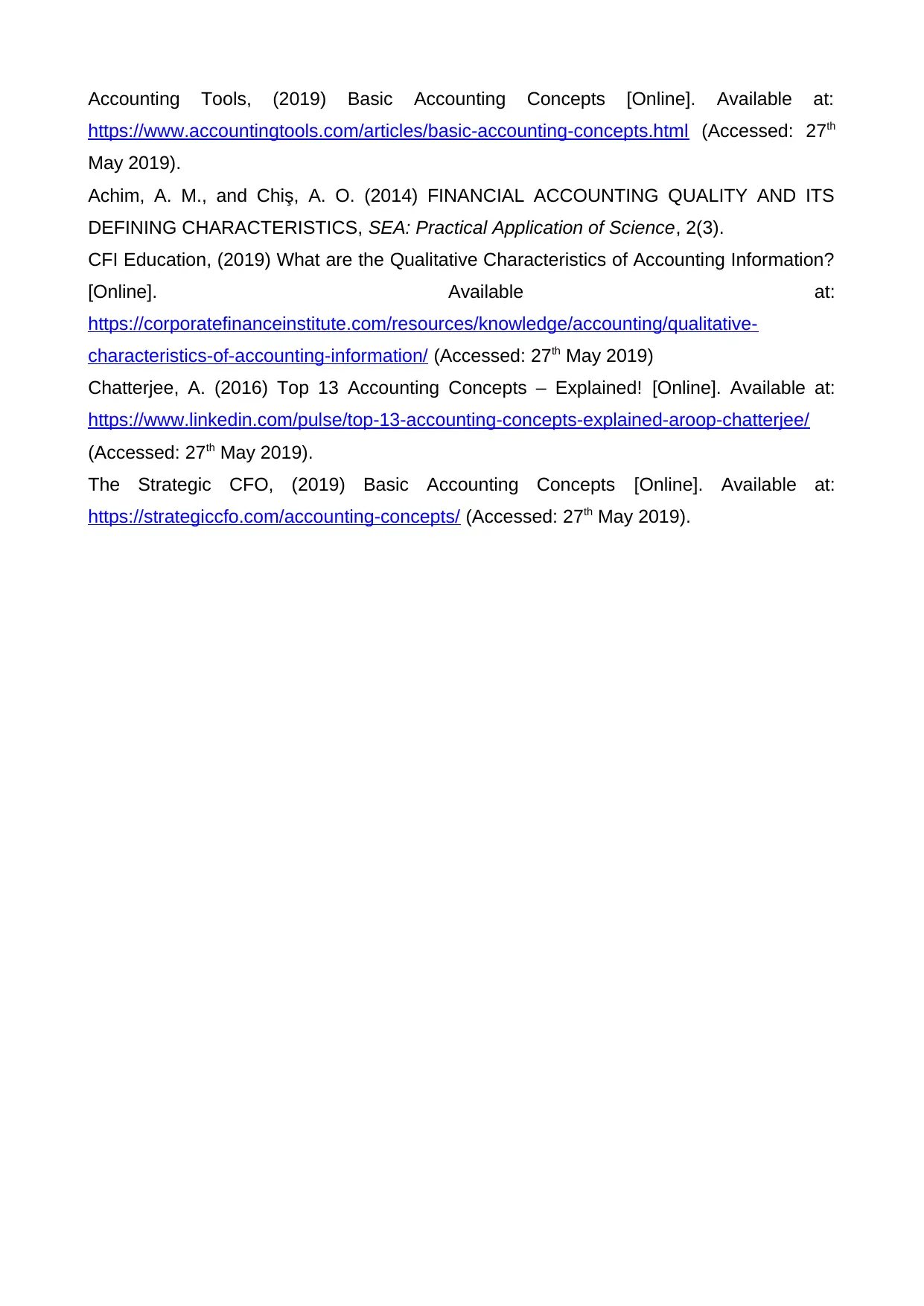
Accounting Tools, (2019) Basic Accounting Concepts [Online]. Available at:
https://www.accountingtools.com/articles/basic-accounting-concepts.html (Accessed: 27th
May 2019).
Achim, A. M., and Chiş, A. O. (2014) FINANCIAL ACCOUNTING QUALITY AND ITS
DEFINING CHARACTERISTICS, SEA: Practical Application of Science, 2(3).
CFI Education, (2019) What are the Qualitative Characteristics of Accounting Information?
[Online]. Available at:
https://corporatefinanceinstitute.com/resources/knowledge/accounting/qualitative-
characteristics-of-accounting-information/ (Accessed: 27th May 2019)
Chatterjee, A. (2016) Top 13 Accounting Concepts – Explained! [Online]. Available at:
https://www.linkedin.com/pulse/top-13-accounting-concepts-explained-aroop-chatterjee/
(Accessed: 27th May 2019).
The Strategic CFO, (2019) Basic Accounting Concepts [Online]. Available at:
https://strategiccfo.com/accounting-concepts/ (Accessed: 27th May 2019).
https://www.accountingtools.com/articles/basic-accounting-concepts.html (Accessed: 27th
May 2019).
Achim, A. M., and Chiş, A. O. (2014) FINANCIAL ACCOUNTING QUALITY AND ITS
DEFINING CHARACTERISTICS, SEA: Practical Application of Science, 2(3).
CFI Education, (2019) What are the Qualitative Characteristics of Accounting Information?
[Online]. Available at:
https://corporatefinanceinstitute.com/resources/knowledge/accounting/qualitative-
characteristics-of-accounting-information/ (Accessed: 27th May 2019)
Chatterjee, A. (2016) Top 13 Accounting Concepts – Explained! [Online]. Available at:
https://www.linkedin.com/pulse/top-13-accounting-concepts-explained-aroop-chatterjee/
(Accessed: 27th May 2019).
The Strategic CFO, (2019) Basic Accounting Concepts [Online]. Available at:
https://strategiccfo.com/accounting-concepts/ (Accessed: 27th May 2019).
1 out of 10
Related Documents
Your All-in-One AI-Powered Toolkit for Academic Success.
+13062052269
info@desklib.com
Available 24*7 on WhatsApp / Email
![[object Object]](/_next/static/media/star-bottom.7253800d.svg)
Unlock your academic potential
Copyright © 2020–2025 A2Z Services. All Rights Reserved. Developed and managed by ZUCOL.





